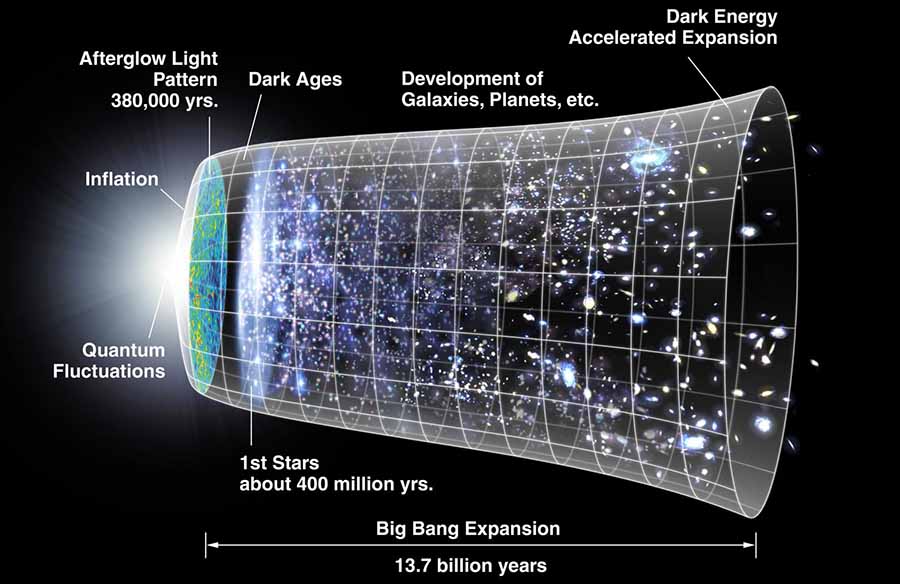

The Big Bang theory is the prevailing cosmological model explaining the existence of the observable universe from the earliest known periods through its subsequent large-scale evolution. The model describes how the universe expanded from an initial state of high density and temperature, and offers a comprehensive explanation for a broad range of observed phenomena, including the abundance of light elements, the cosmic microwave background (CMB) radiation, and large-scale structure.
Crucially, the theory is compatible with HubbleÐLema”tre law - the observation that the farther away a galaxy is, the faster it is moving away from Earth. Extrapolating this cosmic expansion backwards in time using the known laws of physics, the theory describes an increasingly concentrated cosmos preceded by a singularity in which space and time lose meaning (typically named "the Big Bang singularity"). Detailed measurements of the expansion rate of the universe place the Big Bang singularity at around 13.8 billion years ago, which is thus considered the age of the universe.
After its initial expansion, an event that is by itself often called "the Big Bang", the universe cooled sufficiently to allow the formation of subatomic particles, and later atoms. Giant clouds of these primordial elements - mostly hydrogen, with some helium and lithium - later coalesced through gravity, forming early stars and galaxies, the descendants of which are visible today.
Besides these primordial building materials, astronomers observe the gravitational effects of an unknown dark matter surrounding galaxies. Most of the gravitational potential in the universe seems to be in this form, and the Big Bang theory and various observations indicate that this excess gravitational potential is not created by baryonic matter, such as normal atoms. Measurements of the redshifts of supernovae indicate that the expansion of the universe is accelerating, an observation attributed to dark energy's existence.
Georges Lema”tre first noted in 1927 that an expanding universe could be traced back in time to an originating single point, which he called the "primeval atom". Edwin Hubble confirmed through analysis of galactic redshifts in 1929 that galaxies are indeed drifting apart; this is important observational evidence for an expanding universe. For several decades, the scientific community was divided between supporters of the Big Bang and the rival steady-state model which both offered explanations for the observed expansion, but the steady-state model stipulated an eternal universe in contrast to the Big Bang's finite age.
In 1964, the CMB was discovered, which convinced many cosmologists that the steady-state theory was falsified, since, unlike the steady-state theory, the hot Big Bang predicted a uniform background radiation throughout the universe caused by the high temperatures and densities in the distant past. A wide range of empirical evidence strongly favors the Big Bang, which is now essentially universally accepted. Read more ...
The Origin Of Dark Matter? Maybe It Came From A Dark Big Bang IFL Science - March 14, 2023
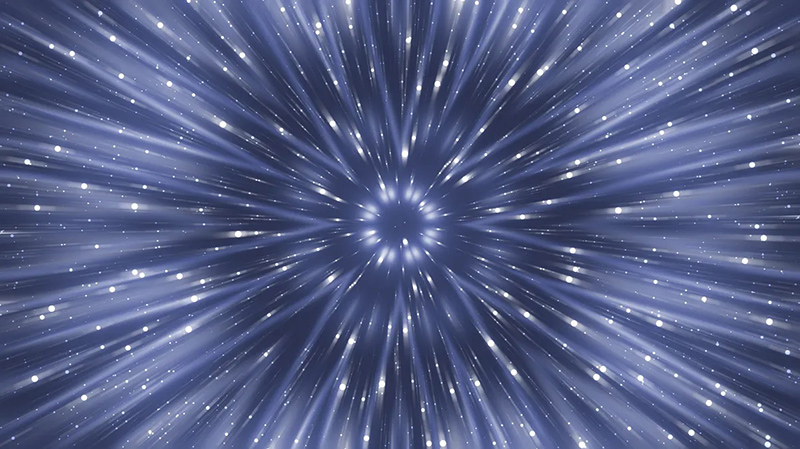
Dark Matter is a hypothetical form of matter thought to account for approximately 85% of the matter in the universe. This article asks the question - Did Dark Matter come from a Dark Big Bang? Think Simulation Theory and the Black Hole of Creation.
The alleged Big Bang was an insert in the simulation of reality. It will Fade to Black and everything that we think is reality will be gone. ~ Ellie Crystal
How Did The Big Bang Arise Out of Nothing? Science Alert - January 4, 2022
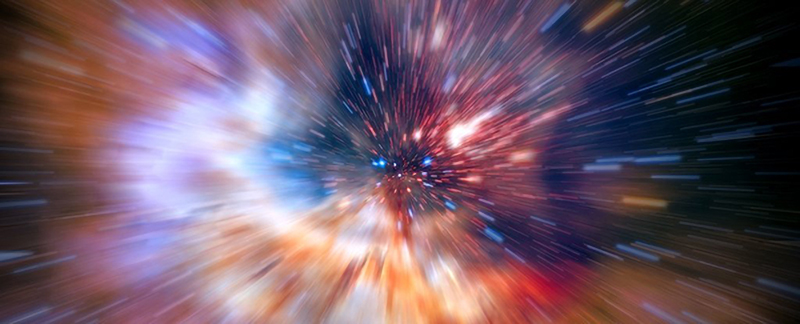
The last star will slowly cool and fade away. With its passing, the Universe will become once more a void, without light or life or meaning. So warned the physicist Brian Cox in the recent BBC series Universe. The fading of that last star will only be the beginning of an infinitely long, dark epoch. All matter will eventually be consumed by monstrous black holes, which in their turn will evaporate away into the dimmest glimmers of light. Space will expand ever outwards until even that dim light becomes too spread out to interact. Activity will cease. Or will it? Strangely enough, some cosmologists believe a previous, cold dark empty Universe like the one which lies in our far future could have been the source of our very own Big Bang.
Fossil from the Big Bang discovered with W. M. Keck Observatory Science Daily - December 18, 2018
A relic cloud of gas, orphaned after the Big Bang, has been discovered in the distant universe by astronomers using the world's most powerful optical telescope, the W. M. Keck Observatory on Maunakea, Hawaii. The discovery of such a rare fossil offers new information about how the first galaxies in the universe formed. The quasar, which emits a bright glow of material falling into a supermassive black hole, provides a light source against which the spectral shadows of the hydrogen in the gas cloud can be seen.
Researchers reveal the story of the oldest stars and galaxies, compiled from 20 years of simulating the early universe PhysOrg - October 17, 2018

The Big Bang has captured our imagination like no other theory in science: the magnificent, explosive birth of our Universe. But do you know what came next? Code was created which allowed formation of the first stars in the universe to be modeled. These equations describe the movement and chemical reactions inside gas clouds in a universe before light, and the immense gravitational pull of a much larger but invisible mass of mysterious dark matter.
Researchers find new way of exploring the afterglow from the Big Bang PhysOrg - April 19, 2018
Researchers have developed a new way to improve our knowledge of the Big Bang by measuring radiation from its afterglow, called the cosmic microwave background radiation. The new results predict the maximum bandwidth of the universe, which is the maximum speed at which any change can occur in the universe.
Is Dark Matter Made Up of Mini Black Holes from the Big Bang? Live Science - April 6, 2018
Dark matter, the mysterious extra mass in the universe that emits no light yet exerts a gravitational pull, may actually be made up of primordial black holes that originated with the Big Bang. And these mini black holes can thank the Higgs boson for their birth - at least according to a new theory. This theory posits that these primeval black holes were created from instabilities in the field that gives rise to the Higgs Boson, the mysterious "God" particle discovered at the Large Hadron Collider (LHC).
A Second 'Big Bang' Could End Our Universe in an Instant, Thanks to The Higgs Boson Science Alert - April 5, 2018
Our universe may end the same way it was created: with a big, sudden bang. That's according to new research from a group of Harvard physicists, who found that the destabilization of the Higgs boson - a tiny quantum particle that gives other particles mass - could lead to an explosion of energy that would consume everything in the known universe and upend the laws of physics and chemistry.
What happened before the Big Bang? Professor Stephen Hawking says time existed in a 'bent state' that was distorted along another dimension Daily Mail - March 5, 2018
At the time of the Big Bang 13.8 billion years, all matter in the universe erupted from a singularity to create the cosmos that we know today. What happened before the Big Bang? Professor Stephen Hawking says time existed in a 'bent state' that was distorted along another dimension. Big Bang was the formation of what we now regard as time because the event broke down the laws of physics. This means that anything that preceded it cannot be applied to our understanding of time and existence. Essentially, there was no conceivable 'boundary' of time until the Big Bang. According to this theory, the history of the universe is not a flat line but a four-dimensional, curved object, 'like the surface of the Earth, but with two more dimensions', Hawking said.
World's Fastest-Swirling Vortex Simulates the Big Bang Live Science - August 8, 2017

Faster than a tornado, speedier than the giant storm swirling on Jupiter - it's the world's fastest-swirling vortex, which scientists have created in a primordial soup of gluey particles meant to re-create the Big Bang. The swirling particle soup rotates at head-snapping speeds - many times faster than the closest contenders. However, don't expect this fast-spinning fluid to turn heads anytime soon, as the vortices occur in a material called a quark-gluon plasma that is so small that the signature of this whirling can be detected only by the particles it produces.
Is the universe ringing like a crystal glass? PhysOrg - June 27, 2015
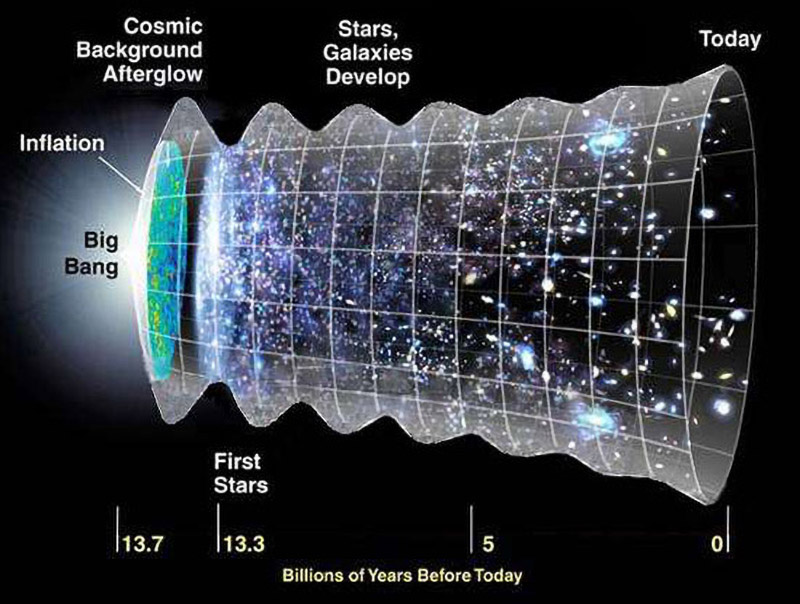
Many know the phrase "the big bang theory." There's even a top television comedy series with that as its title. According to scientists, the universe began with the "big bang" and expanded to the size it is today. Yet, the gravity of all of this matter, stars, gas, galaxies, and mysterious dark matter, tries to pull the universe back together, slowing down the expansion. Now, two physicists at The University of Southern Mississippi, Lawrence Mead and Harry Ringermacher, have discovered that the universe might not only be expanding, but also oscillating or "ringing" at the same time.
Exotic matter: A closer look at the perfect fluid sheds light on what happened microseconds after the Big Bang Science Daily - October 3, 2014
By combining data from two high-energy accelerators, nuclear scientists have refined the measurement of a remarkable property of exotic matter known as quark-gluon plasma. The findings reveal new aspects of the ultra-hot, 'perfect fluid' that give clues to the state of the young universe just microseconds after the Big Bang.
Major Big Bang Discovery Brings 'Theory of Everything' a Bit Closer to Reality Live Science - March 21, 2014
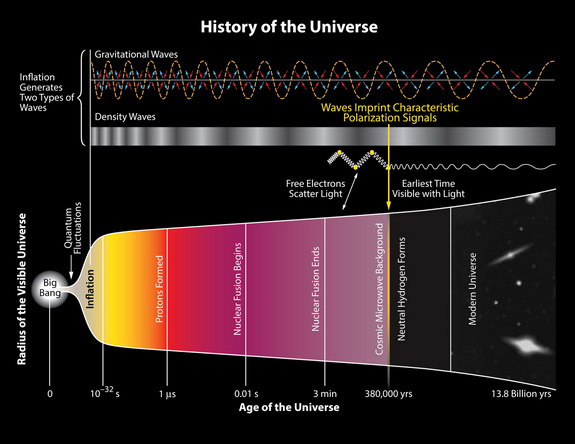
The discovery that the universe really did expand at many times the speed of light immediately after the Big Bang should bring physicists slightly closer to their ultimate goal - the long-sought "Theory of Everything." The bottom part of this illustration shows the scale of the universe versus time. Specific events are shown such as the formation of neutral Hydrogen at 380 000 years after the big bang. Prior to this time, the constant interaction between matter (electrons) and light (photons) made the universe opaque. After this time, the photons we now call the CMB started streaming freely.
Cosmic Microwave Map Swirls Indicate Inflation NASA - March 17, 2014
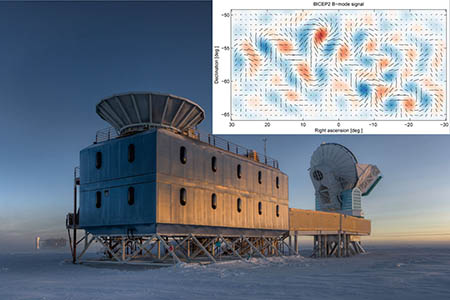
Did the universe undergo an early epoch of extremely rapid expansion? Such an inflationary epoch has been postulated to explain several puzzling cosmic attributes such as why our universe looks similar in opposite directions. Yesterday, results were released showing an expected signal of unexpected strength, bolstering a prediction of inflation that specific patterns of polarization should exist in cosmic microwave background radiation -- light emitted 13.8 billion years ago as the universe first became transparent. Called B-mode polarizations, these early swirling patterns can be directly attributed to squeeze and stretch effects that gravitational radiation has on photon-emitting electrons. The surprising results were discovered in data from the Background Imaging of Cosmic Extragalactic Polarization 2 (BICEP2) microwave observatory near the South Pole. BICEP2 is the building-mounted dish pictured above on the left. Note how the black polarization vectors appear to swirl around the colored temperature peaks on the inset microwave sky map. Although statistically compelling, the conclusions will likely remain controversial while confirmation attempts are made with independent observations.
Cosmic inflation: Spectacular discovery hailed BBC - March 17, 2014
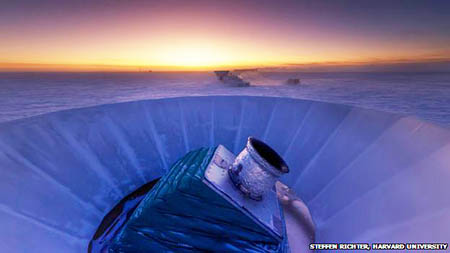
Scientists say they have extraordinary new evidence to support a Big Bang Theory for the origin of the Universe. Researchers believe they have found the signal left in the sky by the super-rapid expansion of space that must have occurred just fractions of a second after everything came into being. It takes the form of a distinctive twist in the oldest light detectable with telescopes. The breakthrough was announced by an American team working on a project known as BICEP2.
Our Universe May Exist in a Multiverse, Cosmic Inflation Discovery Suggests Live Science - March 18, 2014
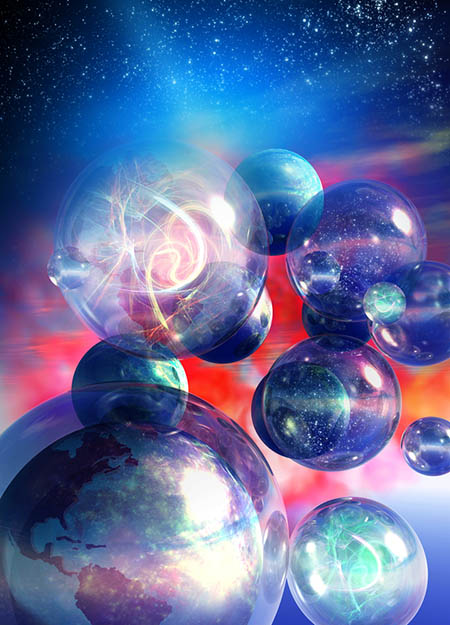
String Theorists Simulate the Big Bang Live Science - December 13, 2011
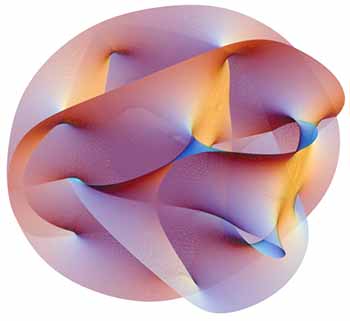
Japanese physicists have created a string theory model that simulates the birth of the universe. In their model, the Big Bang was a "symmetry-breaking event" - a fluctuation that caused three spatial dimensions to break free from the other six dimensions of string theory, then rapidly unfurl to produce our universe's observed 3D structure. String theory - a proposed "theory of everything" that unites quantum mechanics and general relativity together in one complete picture - models elementary particles as oscillating lines ("strings") rather than dimensionless points. In order for the math to work, string theory requires that there be 10 dimensions: nine of space and one of time. Our universe only appears to have three spatial dimensions, string theorists say, because the other six are curled up in undetectably tiny bundles called Calabi-Yau manifolds, which are a minuscule 10^-33 centimeters across.
String theory researchers simulate big-bang on supercomputer PhysOrg - December 14, 2011
A trio of Japanese physicists have applied a reformulation of string theory, called IIB, whereby matrices are used to describe the properties of the physical universe, on a supercomputer, to effectively show that the universe spontaneously ballooned in three directions, leaving the other six dimensions tightly wrapped, as string theory has predicted all along.
Could the Big Bang have been a quick conversion of antimatter into matter? PhysOrg - July 19, 2011
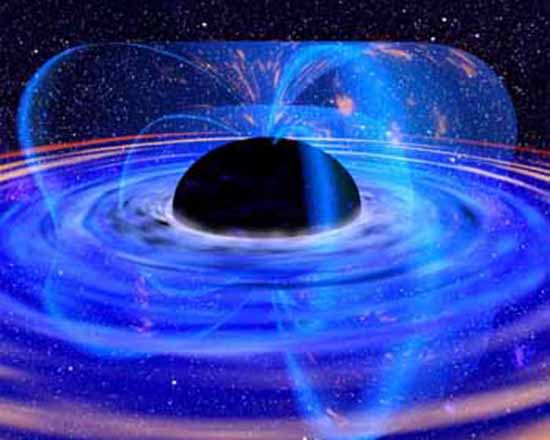
Suppose at some point the universe ceases to expand, and instead begins collapsing in on itself (as in the ÒBig CrunchÓ scenario), and eventually becomes a supermassive black hole. The black holeÕs extreme mass produces an extremely strong gravitational field. Through a gravitational version of the so-called Schwinger mechanism, this gravitational field converts virtual particle-antiparticle pairs from the surrounding quantum vacuum into real particle-antiparticle pairs. If the black hole is made from matter (antimatter), it could violently repel billions and billions of antiparticles (particles) out into space in a fraction of a second, creating an ejection event that would look quite similar to a Big Bang.
Matter Melts in Superhot Particle Collisions Live Science - June 23, 2011
By creating a soup of subatomic particles similar to what the Big Bang produced, scientists have discovered the temperature boundary where ordinary matter dissolves. Normal atoms will be converted into another state of matter - a plasma of quarks and gluons - at a temperature about 125,000 times hotter than the center of the sun, physicists said after smashing the nuclei of gold atoms together and measuring the results. While this extreme state of matter is far from anything that occurs naturally on Earth, scientists think the whole universe consisted of a similar soup for a few microseconds after the Big Bang about 13.7 billion years ago.
Cosmos may show echoes of events before Big Bang BBC - November 27, 2010
Evidence of events that happened before the Big Bang can be seen in the glow of microwave radiation that fills the Universe, scientists have asserted. Renowned cosmologist Roger Penrose said that analysis of this cosmic microwave background showed echoes of previous Big Bang-like events. The events appear as "rings" around galaxy clusters in which the variation in the background is unusually low.